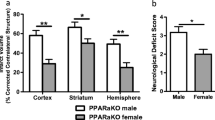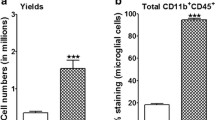Abstract
Inflammatory responses in the brain after cerebral ischemia have been studied extensively in male mice, but not female mice, thus potentially giving a less-than-accurate view of gender associated pathological processes. In humans, cerebral infarcts are typically smaller in premenopausal females than in age-matched males. In the current study, we confirmed smaller infarcts in female vs. male mice after middle cerebral artery occlusion and 96 h of reperfusion. Moreover, we explored immunological alterations related to this difference and found that the percentage of CD4+ T lymphocytes was significantly higher in spleens in males than females, with increased expression of the activation markers, CD69 and CD44. In contrast, the percentage of CD8+ T lymphocytes was significantly higher in spleens of females than males, leading to the identification of a small but distinct population of IL-10-secreting CD8+CD122+ suppressor T cells that were also increased in females. Finally, we observed that males have a greater percentage of activated macrophages/microglia in the brain than females, as well as increased expression of the VLA-4 adhesion molecule in both brain and spleen. This new information suggesting gender-dependent immunological mechanisms in stroke implies that effective treatments for human stroke may also be gender specific.






Similar content being viewed by others
References
Brait VH, Jackman KA, Walduck AK, Selemidis S, Diep H, Mast AE, et al. Mechanisms contributing to cerebral infarct size after stroke: gender, reperfusion, T lymphocytes, and Nox2-derived superoxide. Journal of Cerebral Blood Flow and Metabolism. 2010;30:1306–17.
Alkayed NJ, Harukuni I, Kimes AS, London ED, Traystman RJ, Hurn PD. Gender-linked brain injury in experimental stroke. Stroke. 1998;29:159–66.
Di Carlo A, Lamass M, Baldereschi M, et al. Sex differences in the clinical presentation, resource use, and 3-month outcome of acute stroke in Europe: data from a multicenter multinational hospital-based registry. Stroke. 2003;34:1114–9.
Seshadri S, Beiser A, Kelly-Hayes M, Kase CS, Au R, Kannel WB, et al. The lifetime risk of stroke: estimates from the Framingham Study. Stroke. 2006;37:345–50.
Sudlow CLM, Warlow CP. Comparable studies of the incidence of stroke and its pathological types. Stroke. 1997;28:491–9.
Sacco RL, Boden-Albala B, Gan R, Chen X, Kargman DE, Shea S, et al. Stroke incidence among White, Black, and Hispanic residents of an urban community: the Northern Manhattan Stroke Study. American Journal of Epidemiology. 1998;147:259–68.
Koerner I, Murphy SJ, Hurn PD. Gender, sex steroids, and cerebral ischemic pathobiology. In: Chan P, editor. Acute ischemic injury and repair in the nervous system. New York: Kluwer Academic/Plenum Publishers; 2007. p. 186–207.
Hurn PD, Vannucci SJ, Hagberg H. Adult or perinatal brain injury: does sex matter? Stroke. 2005;36:193–5.
Murphy SJ, McCullough LD, Smith JM. Stroke in the female: role of biological sex and estrogen. ILAR Journal. 2004;45:147–59.
Offner H, Subramanian S, Parker SM, Afentoulis ME, Vandenbark AA, Hurn PD. Experimental stroke induces massive, rapid activation of the peripheral immune system. Journal of Cerebral Blood Flow and Metabolism. 2006;26:654–65.
Allan SM, Rothwell NJ. Inflammation in central nervous system injury. Philosophical Transactions of the Royal Society of London Series B, Biological Sciences. 2003;358:1669–77.
Haast RA, Gustafson DR, Kiliaan AJ. Sex differences in stroke. Journal of Cerebral Blood Flow and Metabolism. 2012;32:2100–7.
Appelros P, Stegmayr B, Terént A. A review on sex differences in stroke treatment and outcome. Acta Neurologica Scandinavica. 2010;121:359–69.
Hurn PD, Subramanian S, Parker SM, Afentoulis ME, Kaler LJ, Vandenbark AA, et al. T- and B-cell-deficient mice with experimental stroke have reduced lesion size and inflammation. Journal of Cerebral Blood Flow and Metabolism. 2007;27:1798–805.
Offner H, Subramanian S, Parker SM, Wang C, Afentoulis ME, Lewis A, et al. Splenic atrophy in experimental stroke is accompanied by increased regulatory T cells and circulating macrophages. The Journal of Immunology. 2006;176:6523–31.
Yanaba K, Bouazis JD, Haas KM, Poe JC, Fujimoto M, Tedder TF. A regulatory B cell subset with a unique CD1dhiCD5+ phenotype controls T cell-dependent inflammatory responses. Immunity. 2008;28:639–50.
Subramanian S, Miller LM, Grafe MR, Vandenbark AA, Offner H. Contribution of GPR30 for 1,25 dihydroxyvitamin D3 protection in EAE. Metabolic Brain Disease. 2012;27:29–35.
Ajmo CT, Vernon DO, Collier L, Hall AA, Garbuzova-Davis S, Willing A, et al. The spleen contributes to stroke-induced neurodegeneration. Journal of Neuroscience Research. 2008;86:2227–34.
Yilmaz G, Arumugam TV, Stokes KY, Granger DN. Role of T lymphocytes and interferon-gamma in ischemic stroke. Circulation. 2006;113:2105–12.
Seifert HA, Hall AA, Chapman CB, Collier LA, Willing AE, Pennypacker KR. A transient decrease in spleen size following stroke corresponds to splenocytes release into systemic circulation. Journal of Neuroimmune Pharmacology. 2012;7:1017–24.
Jin R, Yang G, Li G. Inflammatory mechanisms in ischemic stroke: role of inflammatory cells. Journal of Leukocyte Biology. 2010;87:779–89.
Yilmaz G, Granger DN. Leukocyte recruitment and ischemic brain injury. Neuromolecular Medicine. 2010;12:193–04.
Arumugam TV, Granger DN, Mattson MP. Stroke and T-cells. Neuromolecular Medicine. 2005;7:229–42.
Jackman KA, Miller AA, De Silva TM, Crack PJ, Drummond GR, Sobey CG. Reduction of cerebral infarct volume by apocynin requires pretreatment and is absent in Nox2-deficient mice. British Journal of Pharmacology. 2009;156:680–8.
Kahles T, Luedike P, Endres M, Galla HJ, Steinmetz H, Busse R, et al. NADPH oxidase plays a central role in blood–brain barrier damage in experimental stroke. Stroke. 2007;38:3000–6.
Becker K, Kindrick D, Relton J, Harlan J, Winn R. Antibody to the alpha4 integrin decreases infarct size in transient focal cerebral ischemia in rats. Stroke. 2001;32:206–11.
Liesz A, Suri-Payer E, Veltkamp C, Doerr H, Sommer C, Rivest S, et al. Regulatory T cells are key cerebroprotective immunomodulators in acute experimental stroke. Nature Medicine. 2009;15:192–9.
Relton JK, Sloan KE, Frew EM, Whalley ET, Adams SP, Lobb RR. Inhibition of alpha4 integrin protects against transient focal cerebral ischemia in normotensive and hypertensive rats. Stroke. 2001;32:199–205.
Angele MK, Schwacha MG, Ayala A, Chaudry IH. Effect of gender and sex hormones on immune responses following shock. Shock. 2000;14:81–90.
Pelfrey CM, Cotleur AC, Lee JC, Rudick RA. Sex differences in cytokine responses to myelin peptides in multiple sclerosis. Journal of Neuroimmunology. 2002;130:211–23.
Voskuhl RR, Palaszynski K. Sex hormones in EAE: implications for multiple sclerosis. The Neuroscientist. 2001;7:258–70.
Walder CE, Green SP, Darbonne WC, Mathias J, Rae J, Dinauer MC, et al. Ischemic stroke injury is reduced in mice lacking a functional NADPH oxidase. Stroke. 1997;28:2252–8.
Konya C, Goronzy JJ, Weyand CM. Treating autoimmune disease by targeting CD8+ T suppressor cells. Expert Opinion on Biological Therapy. 2009;9:951–65.
Endharti AT, Rifa'I M, Shi Z, Fukuoka Y, Nakahara Y, Kawamoto Y, et al. Cutting edge: CD8+CD122+ regulatory T cells produce IL-10 to suppress IFN-gamma production and proliferation of CD8+ T cells. The Journal of Immunology. 2005;175:7093–7.
Noble A, Giorgini A, Jamie AL. Distinct suppressor T-cell lineage cytokine-induced IL-10-secreting CD8 T cells represent a phenotypically distinct suppressor T-cell lineage. Blood. 2006;107:4475–83.
Jiang H, Curran S, Ruiz-Vazquez E, Liang B, Winchester R, Chess L. Regulatory CD8+ T cells fine-tune the myelin basic protein-reactive T cell receptor Vβ repertoire during experimental autoimmune encephalomyelitis. PNAS. 2003;100:8378–83.
Ishimaru N, Saegusa K, Yanagi K, Haneji N, Saito I, Hayashi Y. Estrogen deficiency accelerates autoimmune exocrinopathy in murine Sjögren’s syndrome through fas-mediated apoptosis. The American Journal of Pathology. 1999;155:173–81.
Marks MA, Gravitt PE, Burk RD, Studentsov Y, Farzadegan H, Klein SL. Progesterone and 17beta-estradiol enhance regulatory responses to human papillomavirus type 16 virus-like particles in peripheral blood mononuclear cells from healthy women. Clinical and Vaccine Immunology. 2010;17:609–17.
Roof RL, Edward DH. Gender differences in acute CNS trauma and stroke: neuroprotective effects of estrogen and progesterone. Journal of Neurotrauma. 2000;17:367–88.
Zhang B, Subramanian S, Dziennis S, Jia J, Uchida M, Akiyoshi K, et al. Estradiol and G1 reduce infarct size and improve immunosuppression after experimental stroke. The Journal of Immunology. 2010;184:4087–94.
Planas AM, Gómez-Choco M, Urra X, Gorina R, Caballero M, Chamorro Á. Brain-derived antigens in lymphoid tissue of patients with acute stroke. The Journal of Immunology. 2012;188:2156–63.
Yilmaz G, Vital S, Yilmaz CE, Stokes KY, Alexander JS, Granger DN. Selectin-mediated recruitment of bone marrow stromal cells in the postischemic cerebral microvasculature. Stroke. 2011;42:806–11.
Baron JL, Madri JA, Ruddle NH, Hashim G, Janeway Jr CA. Surface expression of alpha 4 integrin by CD4 T cells is required for their entry into brain parenchyma. The Journal of Experimental Medicine. 1993;177:57–68.
Marques CP, Cheeran MC, Palmquist JM, Hu S, Urban SL, Lokensgard JR. Prolonged microglial cell activation and lymphocyte infiltration following experimental herpes encephalitis. The Journal of Immunology. 2008;181:6417–26.
Campanella M, Sciorati C, Tarozzo G, Beltramo M. Flow cytometric analysis of inflammatory cells in ischemic rat brain. Stroke. 2002;33:586–92.
Ponomarev ED, Veremeyko T, Barteneva N, Krichevsky AM, Weiner HL. MicroRNA-124 promotes microglia quiescence and suppresses EAE by deactivating macrophages via the C/EBP–α-PU.1 pathway. Nature Medicine. 2011;17:64–70.
Acknowledgments
The authors wish to thank Dr. Gil Benedek for the helpful discussions and Melissa Barber for the assistance in submitting the manuscript. This work was supported by NIH grant no. NS076013. This material is based upon work supported in part by the Department of Veterans Affairs, Veterans Health Administration, Office of Research and Development, Biomedical Laboratory Research and Development. The contents do not represent the views of the Department of Veterans Affairs or the United States Government.
Conflict of Interest
Anirban Banerjee declares that he has no conflict of interest.
Jianming Wang declares that he has no conflict of interest.
Sheetal Bodhankar declares that she has no conflict of interest.
Arthur A. Vandenbark declares that he has no conflict of interest.
Stephanie J. Murphy declares that she has no conflict of interest.
Halina Offner declares that she has no conflict of interest.
Compliance with Ethics Requirements
All institutional and national guidelines for the care and use of laboratory animals were followed. This article does not contain any studies with human subjects.
Author information
Authors and Affiliations
Corresponding author
Additional information
Anirban Banerjee and Jianming Wang contributed equally to this work.
Rights and permissions
About this article
Cite this article
Banerjee, A., Wang, J., Bodhankar, S. et al. Phenotypic Changes in Immune Cell Subsets Reflect Increased Infarct Volume in Male vs. Female Mice. Transl. Stroke Res. 4, 554–563 (2013). https://doi.org/10.1007/s12975-013-0268-z
Received:
Revised:
Accepted:
Published:
Issue Date:
DOI: https://doi.org/10.1007/s12975-013-0268-z




